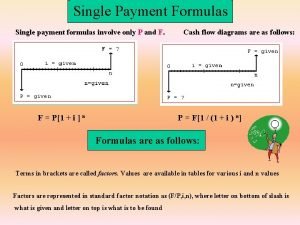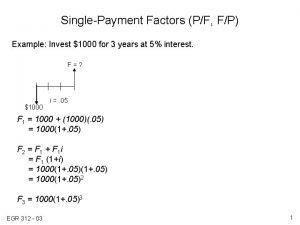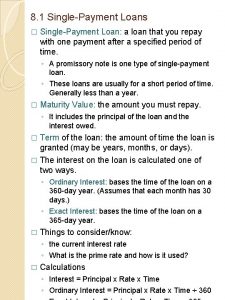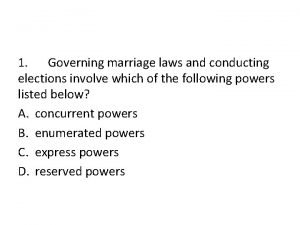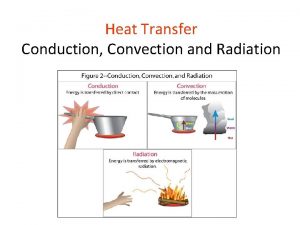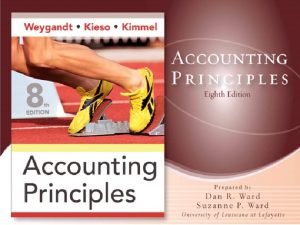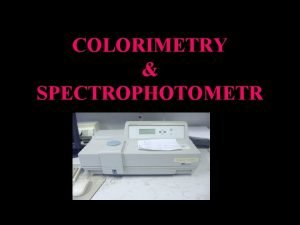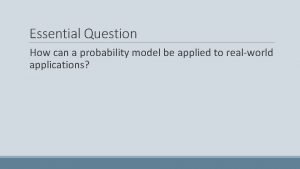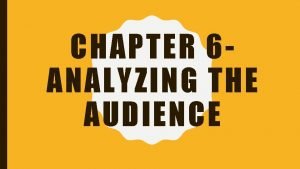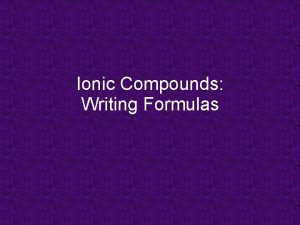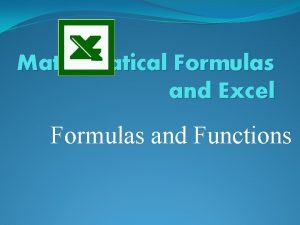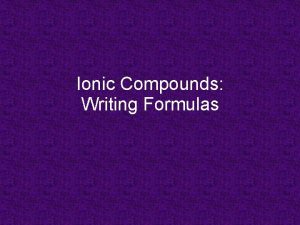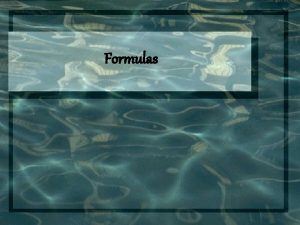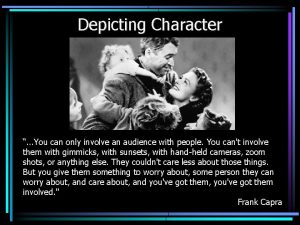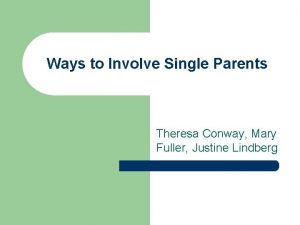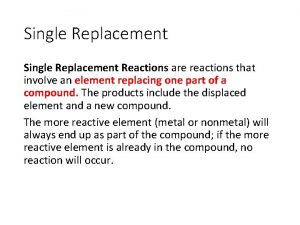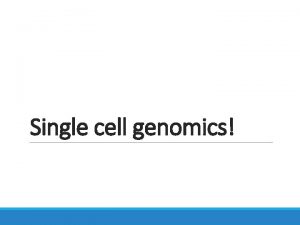Single Payment Formulas Single payment formulas involve only













- Slides: 13

Single Payment Formulas Single payment formulas involve only P and F. F = P[1 + i ] n Cash flow diagrams are as follows: P = F[1 / (1 + i ) n] Formulas are as follows: Terms in brackets are called factors. Values are available in tables for various i and n values Factors are represented in standard factor notation as (F/P, i, n), where letter on bottom of slash is what is given and letter on top is what is to be found

Example 1 : Finding Future Value Statement : A person deposits $5000 into a money market account which pays interest at a rate of 8% per year. The amount in the account after 10 years is closest to : ( A ) $2, 792 ( B ) $ 9, 000 The cash flow diagram is as follows: ( C ) $ 10, 795 ( D ) $12, 165 The solution is as follows: F = P ( F/P , i, n ) = 5000 ( F/P , 8% , 10 ) = 5000 ( 2. 1589 ) = $ 10, 794. 50 Answer is ( C )

Example 2 : Finding Present Value Statement : A small company wants to make a single deposit now so it will have enough money to purchase a new truck costing $50, 000 five years from now. If the account will earn interest of 10% per year, the amount that must be deposited is nearest to: ( A ) $10, 000 ( B ) $ 31, 050 ( C ) $ 33, 250 ( D ) $319, 160 The cash flow diagram is as follows: The solution is as follows: P = F ( P/F , i, n ) = 50000 ( P/F , 10% , 5 ) = 50000 ( 0. 6209 ) = $ 31, 045 Answer is ( B )

Uniform Series Involving P&A These uniform series formulas involve P&A, where A means : (1) Cash flow occurs in consecutive interest periods (2) Cash flow amount is same in each interest period The Cash Flow Diagrams Are As Follows: A=Given 0 1 2 3 P=? A=? 4 5 0 1 2 3 4 P=Given P=A(P/A, i, n) A=P(A/P, i, n) Note: P is One Period Ahead of First A Standard Factor Notation Is As Follows: 5

Example: A Chemical Engineer believes that by modifying the structure of a certain water treatment polymer, his company would earn an extra $5000 per year. At an interest rate of 10% per year, how much could the company afford to spend now just to break even over a 5 year project period? A. $11, 170 B. 13, 640 C. $15, 300 D. $18, 950 The cash flow diagram is as follows: P=5000(P/A, 10%, 5) A=5000(3. 7908) 0 P=? 1 2 3 i = 10% 4 5 =$18, 954 Answer is D

Uniform Series Involving F&A These uniform series formulas involve F&A Cash Flow Diagrams Are As Follows: A=Given 0 1 2 3 A=? 4 5 0 1 2 3 4 F=? F=A(F/A, i, n) A=F(A/F, i, n) Note: F is in Same Period as Last A Standard Factor Notation is As follows: 5 F=Given

Example – An Industrial Engineer made a slight modification to a chip manufacturing process which will save her company $10, 000 per year. At an interest rate of 8 % per year, how much would the savings amount to in 7 years? A $45, 300 B. $68, 500 C. $89, 228 D. $151, 500 The cash flow diagram is as follows: F=? i=8% 0 1 2 3 4 A=10, 000 5 6 7 F=10, 000(F/A, 8%, 7) =10, 000(8. 9228) =$89, 228 Answer is C

Arithmetic Gradients Change by the Same Amt Each Period The Cash Flow Diagram for the PW of a Gradient is as Follows: P=? 1 2 3 4 n Note that P is Two Periods Ahead of the First G 0 G Standard Factor Notation is: P=G(P/G, i, n) 2 G 3 G (n-1)G If there is Cash Flow in Period 1, it is a “Base Amount” which is handled separately as a uniform series, A A gradient can also be converted into an A value using the (A/G, i, n) factor

Example: The Present Worth of $400 in year 1 and amounts increasing by $30 per year thru year 5 at an interest rate of 12% per year is: (a) $1532 (b) $1, 634 (c) $1, 744 (d) $1, 829 Solution: The cash flow diagram is as follows: P=? i=12% 1 2 3 4 5 Year P=400(P/A, 12%, 5) + 30(P/G, 12%, 5) =400(3. 6048) + 30(6. 3970) 0 400 430 G = 30 = $1, 633. 83 460 Answer is (b) 490 520 The cash flow could also be converted into an A value as follows: A = 400 + 30(A/G, 12%, 5) = 400 + 30(1. 7746) =$453. 24

Geometric Gradients Change by the Same Percentage Each Period Cash Flow Diagram for Present Worth of Geometric Gradients is as follows: P=? 1 0 2 3 4 n There are no Tables for Geometric Factors Use Following Equation: P=A{1 -[(1+g)/(1+i)]n}/(i-g) A A(1+g)1 A(1+g)2 Where: A=Cash Flow in Period 1 g=Rate of increase A(1+g)n-1 If g=i, P=An/(1+i) Note: If g is negative, change signs in front of both g’s

Example: Find the present worth of $1, 000 in year 1 and amounts increasing by 7% per year thru year 10. Use an interest rate of 12% per year. (a) $5, 670 (b) $7, 335 (c) $12, 670 (d)$13, 550 Solution: P=1000[1 -(1+0. 07/1+0. 12)10]/(0. 12 -0. 07) = $7, 333 Answer is (b)

These problems involve solving for i, given n and 2 other values(P, F, or A) (They usually require a trial & error solution or interpolation in interest tables) Example: A contractor purchased equipment for $60, 000 which provided income of $16, 000 per year for 10 years. The annual rate of return that was made on the investment was closest to: (a) 15% (b) 18% (c) 20% (d) 24% Solution: Can use either the P/A or A/P factor. Using A/P: 60, 000(A/P, i%, 10) = 16, 000 (A/P, i%, 10) = 0. 26667 From A/P column at n = 10 in the interest tables, i is between 22% and 24% Answer is (d)

These problems involve solving for n, given i and 2 other values(P, F, or A) (They usually require a trial & error solution or interpolation in interest tables) Example: A contractor purchased equipment for $60, 000 which provided income of $8, 000 per year. At an interest rate of 10% per year, the length of time required to recover the investment was closest to: (a) 10 years (b) 12 years (c) 15 years (d) 18 years Solution: Can use either the P/A or A/P factor. Using A/P: 60, 000(A/P, 10%, n) = 8, 000 (A/P, 10%, n) = 0. 13333 From A/P column in 10 % interest tables, n is between 14 and 15 years Answer is (c)
 Leave only footprints take only photos
Leave only footprints take only photos Single payment formula
Single payment formula Single payment examples
Single payment examples Section 8-1 single payment loans
Section 8-1 single payment loans Governing marriage laws and conducting elections involve
Governing marriage laws and conducting elections involve What is radiation examples
What is radiation examples Which decision will involve no incremental revenues?
Which decision will involve no incremental revenues? How colorimeter works
How colorimeter works Do these situations involve bernoulli trials
Do these situations involve bernoulli trials Marketing involve engaging directly with carefully targeted
Marketing involve engaging directly with carefully targeted What does being audience-centered involve
What does being audience-centered involve Meiosis 1 spermatogenesis
Meiosis 1 spermatogenesis What does leadership involve
What does leadership involve Insight therapies involve verbal interactions
Insight therapies involve verbal interactions

